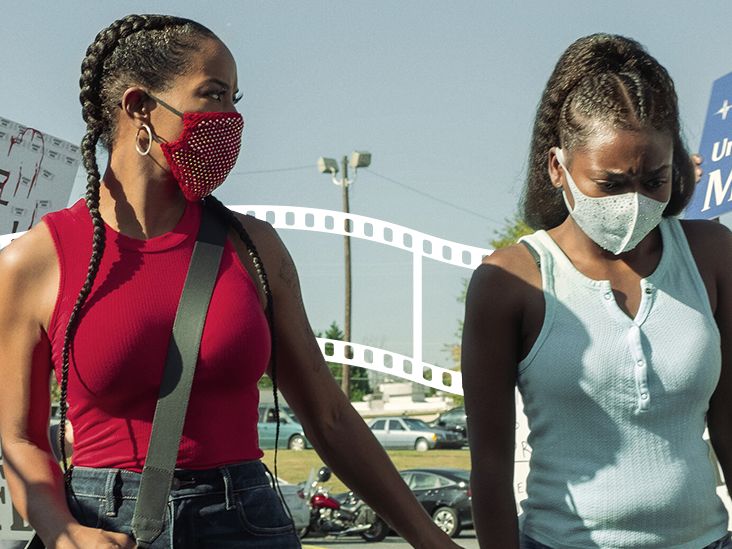Content warning for drug and alcohol use and addiction.
Now that Sober October has passed, Healthline took a look at how the media depicts alcohol and substance abuse, zooming in on how it shows up in the Queer and Black communities considering disparities such as:
- LGBTQ+ communities report usage of opiates at higher rates than their cishet counterparts, highlighting the use of substances as coping mechanisms.
- Black folks are sentenced and incarcerated
more often and often for longer periods of time, despite White drug users engaging in illicit drug use the same amount as their Black counterparts.
“Recovery… is the process of becoming more capable of consenting to oneself,” Harold Hong, M.D., the medical director of New Waters Recovery — a new recovery-oriented drug rehabilitation and treatment center in Raleigh, North Carolina — told us.
We spoke with Hong about the important components of recovery and its portrayal on-screen through hit shows “Dopesick” and “The Chi.”
The stark difference in the way drug users of color, particularly Black folks, are portrayed on camera is similar to the way they’re treated when it comes to policy and policing.
Black users of opioids have historically been subject to scrutiny for their drug use and been subject to police force and a lack of sympathy from the legal system, beginning with the “War on Drugs” coined by Richard Nixon in 1971.
This declaration provided legal backing for racial and economic disparities within drug-related arrests and incarcerations, contributing to the ongoing issue of mass incarceration.
Mass incarceration, ongoing racial bias, and substance-related stigma continue to disproportionately affect Black individuals:
- Black people are incarcerated at more than 5 times the rate of whites
- From 1970 to 2000, the rate of incarceration for Black folks more than doubled
- A Black person is 5 times more likely to be stopped by police without just cause
Lena Waithe’s “The Chi,” a Showtime drama, attends to this carefully and critically, showing these systemic workings that underpin addiction in communities of color.
Viewers see the structural forces like the police, the mayor’s office, and the neighborhood-based 63rd Street Mob acting most evidently on the lives of the cast.
The most visible vices are marijuana and alcohol, with opiates and other more stigmatized drugs having a big offscreen presence in the show.
“Dopesick,” which Hong shared he’s been watching in his downtime,showcases the opposite side of common depictions.
Media representations of opioid users are often white, shown using pills after receiving a prescription from a physician.
The Hulu series uses Samuel Finnix, the town doctor, as a fictional representation of this, as he has recently learned about the then-new OxyContin through his pharmaceutical rep.
The rep spreads marketing promises that dependence is impossible with OxyContin, thanks to a specially formulated sustained-release coating.
But that proves to be a marketing lie as shown in numerous studies —
Both Macy’s work and its TV counterpart examine the company Purdue Pharma, the producers of OxyContin, and the Sackler family (the owners of the pharmaceutical company) — all of whom profited from its wide and fervent distribution of OxyContin.
Over the course of the series the focal points shift, giving the viewer a glimpse into varied angles of how the company’s false representation of OxyContin ultimately left millions of people stuck in chemical dependence and self-blame.
“Shame is the thing that inhibits recovery,” Hong says.
The medical director says what people seeking recovery need most is support, not a “rock-bottom” revelation or family rejection that pop culture suggests as a solution.
In an example of how quickly patients became addicted, “Dopesick”character Betsy is injured at work, later forming an addiction that began after seeing her doctor. Showing how quickly patients were shown the truth about the drug, Betsy becomes reliant on higher and higher doses of OxyContin.
She tries to quit, but her body is dependent. Soon, she’s seeking heroin because the medically-controlled Oxys are difficult to get and the dosage isn’t high enough, similar to many of Finnix’s other patients.
In the throes of withdrawal from OxyContin, Betsy’s past decisions end up affecting others around her.
She causes a fatal accident at work when she nods off and misreads the numbers on an indicator, and Betsy’s girlfriend Grace leaves when she can’t stand Betsy’s addiction anymore.
Without any relationships to lean on, the only relief Betsy has from her grief and shame is getting high.
Opiates vs Alcohol
According to Hong, one of the problems with mainstream residential recovery centers is that they are often structured following the twenty-eight day alcohol detox model, despite the fact that alcohol and opiates affect the body differently.
Hong tells me that it takes two years to rewire the neural pathways carved by opiates, which operate at a deeper level physiologically than does alcohol.
Opiates carry more social and legal stigma than alcohol, and Hong suggests that the greater shroud of shame around people who use opiates means that less careful and scientifically-based attention is given to them by researchers and medical providers.
Because of this, people seeking treatment for addiction to opiates often
Difficulty with Queer identity
In “Dopesick,” Betsy’s been hiding her queerness in her small hometown. When she tries to come out to her homophobic and traditionally Christian parents, they reject her, adding to the overall grief and loneliness that fuels her drug usage.
In “The Chi,” when Trig returns to Chicago, he attempts to take up a responsible mantle to care for his girlfriend, Imani, and younger brother.
But, because his girlfriend is trans, we see that Trig has been hiding his own shame surrounding what others would think of his sexuality.
Trig hides that part of her identity out of fear, and because Imani is committed to Trig and invested in their life together, she deals with Trig’s transphobia.
Viewers see that Imani misses queer people and a life in which she is not the only trans woman. She wants Trig to understand her and where she comes from.
Experiencing open queerness at the bar proves too much for Trig, and he and Imani get into a fight outside the bar. This forces Trig to reckon openly with Imani’s transness and with his desire for Imani, forcing him to choose between tending his transmisogyny and building a life with her.
Alcohol’s legality and social legitimacy gives both “Dopesick” and “The Chi”the opportunity to show the ways that both marijuana and alcohol use create possibilities for connection alongside dependence and disruption.
For instance, a Christmas Eve montage in season 5 of “The Chi” depicts a number of different couples sharing a drink, a joint, and a moment of sexual intimacy, suggesting some parallel pleasure and peace between scenes and substances.
In season 4, a gay bar offers a safe place for a trans character to find others like her and not feel so alone, and following the Pulse shooting of 2016, we know how vital spaces like these are for the community.
And within the show, a reckoning between Trig and Imani facilitated by their trip to this gay bar brought them closer together.
In “Dopesick,” after learning that Betsy is seeing Grace, an out lesbian, one of the first scenes viewers see of them together includes the sharing of alcohol.
Viewers have just learned of their secret relationship, making the sharing of the liquor bottle a possible symbol of their need to get away from their every day routine of forced conformity.
Several episodes into the series Finnix gets in a car accident and is prescribed OxyContin for his own pain. Soon he’s crossing state lines seeking new prescribers because the doses available to him aren’t high enough.
Eventually he loses his medical license, then his freedom. After his release from prison it’s suboxone — not abstinence — that helps Finnix go into recovery.
It’s suboxone’s transformative properties over his own agency that inspire him to regain that license in order to help other people access Medication-Assisted Treatment, or MAT.
Harm-reduction treatment models focus on protecting the autonomy of drug users rather than demanding abstinence from them, and medications like methadone and suboxone are part of a harm-reduction model of treating opioid use disorder.
According to Hong, these models are based on a philosophy of meeting people where they are and tending to their stated needs, rather than imposing a medical, political, or moral standard that a person seeking treatment did not consent to.
“The Chi” covers a storyline where Imani and Trig help other trans women leave a trap house operated by the Mob.
These women gain autonomy over their living conditions and work together to access the drugs they depend on, rather than being beholden to the Mob, serving as another example of a harm reduction model.
While storylines often push for folks to immediately and completely leave substances behind, this step in the women’s lives is in line with Hong’s recommendations for recovery.
According to Hong, meeting people’s material needs before expecting them to make any major lifestyle changes is vital.
In both “The Chi” and “Dopesick,” autonomy, not sobriety, is demonstrably powerful and scientifically backed.
Hong shares that he likes the show so much because it’s honest about how addiction happens, particularly in Finnix’s ethically complicated and compelling storyline.
The last twenty years of harm reduction research clearly show that attending to the knowledge people who use drugs have about their own needs, rather than operating on abstinence-only, punishment-based treatment models is most highly linked to increased well being in the lives of drug users.
Trig and Imani’s relationship showcases the oft complicated dynamics of living at the intersections of multiple marginalized identities and uplifting the importance of community.
The tangible supports of shelter and a MAT program are what allow the women in the trap house and Finnix to decide for themselves about the lives they’re living.
In line with Hong’s perspective, these are examples of consenting to themselves, and deciding not to just quit, but to recover.


